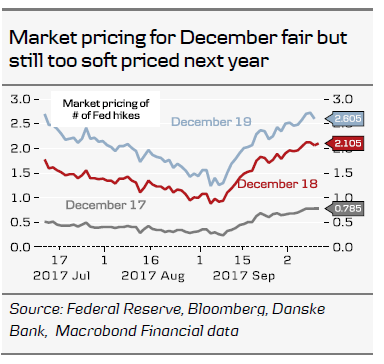In our view, there was nothing new of great importance in the FOMC minutes, as we already know the different positions among the FOMC members. This also explains why markets did not react to the minutes. While the most dovish FOMC members (Brainard, Evans and Kashkari) are arguing that the Fed should not hike further this year, as low inflation may not be just transitory due to low inflation expectations and labour market slack, the core FOMC members think it is appropriate to tighten monetary policy further, as above-trend growth tightens the labour market further, which eventually leads to higher wage growth and hence higher inflation; in other words, they still have a strong belief in the Phillips curve. They will likely feel relieved by the latest average hourly earnings figures, which came out much higher than expected in September.
It remains our base case that the Fed hikes in December, as the core voting FOMC members put more weight on labour market data than current inflation data, although we agree with the dovish camp that low inflation may not be temporary due to low inflation expectations. It is difficult to say what happens next year, as we do not know who the next Fed chair is and who the Fed nominates for the vacant seats on the Board of Governors. Our base case is right now two hikes. While market pricing for a December hike seems fair, markets still price in too few hikes next year.
What we looked for were any discussions on the Fed’s target level for its balance sheet. However, as expected, there was nothing on this, as the Fed likely wants to keep its flexibility adjusting the target along the way. ‘Quantitative tightening’ is new to the Fed, so it likely does not see any benefits from pre-committing. As we have written previously, it is not straightforward just to shrink the balance sheet due to increased regulation, see Research US: Fed’s regulatory hurdle for starting quantitative tightening. The Fed has also acknowledged this and said that the level will be higher than before the crisis.














